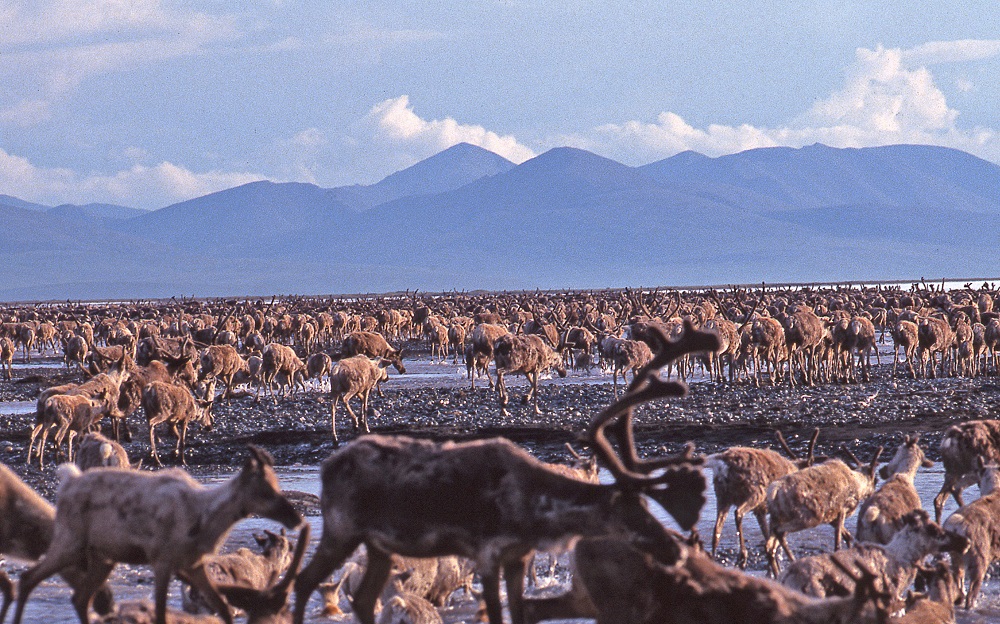Protect The Arctic Refuge From Oil Industry Allies In Congress

Author Toni Armstrong lives in St. Louis and serves on the board of Alaska Wilderness League. This piece originally appeared in the St. Louis Post-Dispatch.
Above – The Porcupine Caribou Herd calves annually on the Coastal Plain of the Arctic National Wildlife Refuge. (Richard Spener Photography)
By Toni Armstrong
Last week, the U.S. Senate voted on a tax reform bill which includes a controversial rider to drill in the biological heart of the Arctic National Wildlife Refuge.
The rationale for adding drilling in the Arctic Refuge to the tax bill was that it would raise revenues and help balance the budget, but the numbers are way off. Average on-shore drilling leases are $34 an acre. Companies would have to bid an average of $2,400 per acre on every single acre of the 1.5 million acre Coastal Plain. Even if every acre of the 1.5 million acres were drilled, which is not realistic, the numbers don’t add up.
Hiking the Coastal Plain in the Arctic National Wildlife Refuge. (Richard Spener Photography)
This drilling debate has raged for nearly 40 years. President Jimmy Carter signed the Alaska National Interest Lands Conservation Act of 1980 on his way out, which designated lands in Alaska as national parks, refuges, forests and wilderness areas. But, the fate of the Coastal Plain of the Arctic National Wildlife Refuge was left in limbo — it would take an act of Congress to open it and an act of Congress to designate it as wilderness. The oil lobby has tried and failed to influence Congress to open the Arctic Refuge to drilling. Today, the Coastal Plain continues to remain in political purgatory, with members of Congress still using the same old tactics to skirt the will of the American people and open up it to drilling.
For me, it is an easy answer: The Arctic Refuge should be protected as wilderness.
Musk ox can be found throughout the Arctic Refuge. (Richard Spener Photography)
For adventurers and wildlife lovers, this is the experience of a lifetime. Conservationist Olaus Murie said it well: “The Arctic Refuge is a little portion of our planet left alone.” My husband and I have visited the Refuge a half-dozen times, dropped off by a small plane in a remote location with our canoes and supplies. We have stood in the midst of 180,000 grunting caribou, their hooves clicking and calves bleating for their mothers. We have experienced standing in this remote place and seen land stretching as far as the eye can see, punctuated by the majestic Brooks Range. And we have observed and photographed a small fraction of the hundreds of species of birds that nest and raise their young in the Arctic Refuge, and eventually migrate through all 50 states.
Proponents say that we need the oil. However, we cannot drill our way to energy security or lower gasoline prices as long as our nation sits on just 3 percent of world oil reserves. It is foolhardy to drill in the Arctic Refuge for any reason, let alone to save just a few pennies on the gallon. Once the Arctic Refuge is lost, it is gone forever.
The Kongakut River winds through the Brooks Range in the Arctic Refuge. (Richard Spener Photography)
We have seen what happens when we drill — just look at the Deepwater Horizon and Exxon Valdez disasters. When we drill, we inevitably spill. An oil spill in the fragile Arctic Refuge would devastate the home of the largest denning population of U.S. polar bears and the Gwich’in people who have subsisted on the Porcupine Caribou Herd for millennia.
Alaska is feeling the impacts of fossil fuel development and climate change like no other place on Earth — communities are literally falling into the sea, permafrost is melting, and the government is relocating communities in order to deal with these impacts.
Our leaders have a moral responsibility to protect this iconic place for future generations. Not everyone in their lifetime will visit the Arctic National Wildlife Refuge, but if we plunder these places for greed then what becomes of our country? These lands define us and are part of what makes our country great.
A fox searches for food along the tundra. (Richard Spener Photography)
Americans have a legacy of protecting our natural wonders. I can only hope our congressional leaders consider the legacy they are inevitably leaving behind and ensure that Arctic Refuge drilling is kept out of any final tax package.
How you can help.





